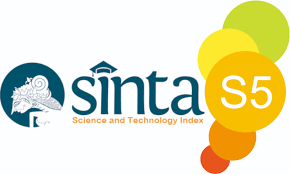Itemizes East Java Heritage Tourism Nexus: In Consort of “Pentahelix” Method via Didactic Vicissitudes Adherence
 Abstract views: 466
,
Abstract views: 466
,
 PDF downloads: 244
PDF downloads: 244
Abstract
As 21st century and/ or urban spots skyrocketing nonstop, particularly at East Java, a bunch of anti-outmoded places’ quantity exceeds both heritage and monumental tourism sites. Attempting archaic didactic principles in familiarizing pupils with heritage tourism equals nothing, nor is (using) printed book; a fine-tech focal notion shall be done. This research heads renewal worth noting idea, it’s antihelix; the method coalesces Academician, Business, Community, Government, and Media abbr. ABCGM, thus, foregoing fifth stakeholders can emerge a distinct tactic of transferring heritage tourism science to students. It can by locating learners’ interests via sophisticated 5.0 features e.g. Virtual Reality/ VR, Augmented Reality/ AR, 3D Demo, etc. To do so, pupils’ endeavour forecast is aimed at history-savvy, minifying heritage unawareness, and nurturing annals of historic sites. A resilient historic site encompasses Edu-tourism importance, with a view from within. This research has ≤ 38 respondents (from 29 regencies and 8 cities in East Java province) whose essence about monumental tourism preservation weightiness.
Downloads
References
Ali Bakir, e. a. (2017). Cross-Cultural Issues in Tourism and Hospitality. Tourism and Hospitality Research. 17(3), p. 245. England, UK.: SAGE.
Ankomah, P. &. (2000). Education Tourism: A Strategy to Strategy to Sustuinable Tourism Development in Sub-Saharan Afrika. DPMN Bulletin, 7(1), 19-24.
Applefeld, N. (2013). Four Ways to Reinvent Retail Marketing through Augmented Reality. Retrieved from Spin Sucks: http://spinsucks.com/marketing/four-ways-to-reinvent-retail-marketing-throughaugmented-reality/
Assistant Deputy of Cultural Tourism Development; Deputy for Industrial and Institutional Development. (2019). Pedoman Pengembangan Wisata Sejarah Dan Warisan Budaya. Jakarta Selatan: Ministry of Tourism Republic of Indonesia.
Caldevilla-Dominguez, D., Martinez-Sala, A., & Barrientos-Baez, A. (2021). Tourism and ICT. Bibliometric Study on Digital Literacy in Higher Education. Education Sciences, 11, 1-17.
Chang, H.-J. (2020). The Flipped Classroom Approach for Tourism English Learners. English Teaching, 75(3), 96.
Cianciarulo, D. (2015). From local traditions to "augmented reality". The MUVIG Museum of Viggiano (Italy). Procedia: Social and Behavioral Sciences, 138-143.
Garau, C. (2014). From Territory to Smartphone: Smart Fruition of Cultural Heritage for Dynamic Tourism Development. Planning Practice and Research, 29(3), 238-255.
Huang, C. (2008). English Curriculum Planning for Hospitality. Proceedings of 2008 International Conference of Applied Foreign Languages, 138-140.
Hyman, P. (2013). Augmented-Reality Glasses Bring Cloud Security Into Sharp Focus. Communications of the ACM, 56(6), 18-20.
Koca, N., & Yildirim, R. (2018, April 4). Relationship between Geography-Tourism and Tourism's Effects According to High School Students. Review of International Geographical Education Online (RIGEO), 8(1), 26-52.
Leslie, M. S. (2006). International Cultural Tourism: Management, Implications, and Cases. Oxford: ELSEVIER.
Liarokapis, F. B.-O. (2006). Exploring urban environments using virtual and augmented reality. Journal of Virtual Reality and Broadcasting, 3(5), 1-13.
Maria D. Alvarez., F. M. (Ed.). (2016). Heritage Tourism Destinations. Wallingford, Oxfordshire, UK: CABI.
Mariya M. Gorovay, (. a. (2017). Didactic Principles of University Information Educational Systems Designing. Eurasian Journal of Analytical Chemistry, 12(7b), 1206.
Monika, M.-K. (2012). Cultural, Economic and social sustainability of heritage tourism: Issues and challenges, Economic and Environmental Studies (E&ES). Economic and Environmental Studies, 12(2), 113-133.
Nagy, K. (2012). Heritage Tourism, Thematic Routes and Possibilities for Innovation. Clubs of Economics in Miskole/ Journal of Economic Literature (JEL), 8(1), 46-53.
Nilsson, P. A. (2018, March). Impact of Cultural Heritage on Tourists. The Heritagization Process. Athens Journal of Tourism, 5(1), 35-54.
Pravin S, e. a. (2000). Sustainable Heritage Tourism: Framework, Perspective and Prospect. National Geographic Journal of India, 46(1-2), 141-158.
Prima, V. (2020). Terminological Field in English Tourism Discourse. Language Teaching Research Quarterly, 14, 69-79.
Provinsi Jawa Timur. (2021). Rencana Kerja Pemerintah Daerah (RKPD) Prov. Jatim. Pemprov Jatim.
Stefano Del Lungo, e. a. (2015). Landscape and cultural heritage: best practices for planning and local development: an example from Southern Italy. Procedia: Social and Behavioral Sciences, 95-102.
Stoep, G. V. (2007). Consideration of Historical Authenticity in Heritage Tourism Planning and Development. Proceeding of the 2007 Northeastern Recreation Research Symposium (pp. 292-298). Lansing, MI: Michigan State University.
Warapon Ngamsomsuke, e. a. (2011). Sustainable Cultural Heritage Tourism Indicators. International Conference on Social Science and Humanity, 5, 516-519.
Zoltan Budjoso, e. a. (2015). Basis of heritegization and cultural tourism development. Procedia: Social and Behavioral Sciences, 307-315.
Copyright (c) 2021 Sultan Bagus Firmansyah

This work is licensed under a Creative Commons Attribution-ShareAlike 4.0 International License.
Authors who publish with this journal agree to the following terms:
- The author (s) keeps copyright on any article.
- The author grants the journal, right of first publication with the work simultaneously licensed under a Creative Commons Attribution License that allows others to share the work with an acknowledgement of the work’s authorship and initial publication in this journal.
- Authors can enter separate, additional contractual arrangements for the non-exclusive distribution of the journal’s published version of the work (e.g., post it to an institutional repository or publish it in a book), with an acknowledgement of its initial publication in this journal.
- Authors are permitted and encouraged to post their work online (e.g., in institutional repositories or on their website) prior to and during the submission process, as it can lead to productive exchanges, as well as earlier and greater citation of published work.
- We distributed the article, and any associated published material under the Creative Commons Attribution-Share alike 4.0 International License




